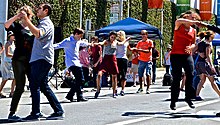 Peter Loggins and Mia Goldsmith swing dancing at the Moore Theatre, Seattle, Washington. | |
| Genre | Jazz |
|---|---|
| Origin | 1920's, Harlem, New York City, U.S.[1] |
Swing dance is a group of social dances that developed with the swing style of jazz music in the 1920s–1940s, with the origins of each dance predating the popular "swing era". Hundreds of styles of swing dancing were developed; those that have survived beyond that era include Charleston, Balboa, Lindy Hop, and Collegiate Shag.[2][3] Today, the best-known of these dances is the Lindy Hop, which originated in Harlem in the early 1930s.[4] While the majority of swing dances began in African-American communities as vernacular African-American dances, some influenced swing-era dances, like Balboa, developed outside of these communities.
"Swing dance" was not commonly used to identify a group of dances until the latter half of the 20th century. Historically, the term swing referred to the style of jazz music, which inspired the evolution of the dance. Jitterbug is any form of swing dance, though it is often used as a synonym for the six-count derivative of Lindy Hop called "East Coast Swing".[5] It was also common to use the word to identify a kind of dancer (i.e., a swing dancer). A "jitterbug" might prefer to dance Lindy Hop, Shag, or any of the other swing dances. The term was famously associated with swing era band leader Cab Calloway because, as he put it, "[The dancers] look like a bunch of jitterbugs out there on the floor due to their fast, often bouncy movements."[6]
The term "swing dancing" is often extended to include other dances that do not have certain characteristics of traditional swing dances: West Coast Swing, Carolina Shag, East Coast Swing, Hand Dancing, Jive, Rock and Roll, Modern Jive, and other dances developed during the 1940s and later. A strong tradition of social and competitive boogie woogie and Rock 'n' Roll in Europe add these dances to their local swing dance cultures.[7]

